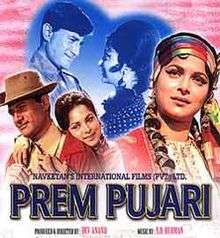Prem Pujari
| Prem Pujari | |
|---|---|
 | |
| प्रेम पुजारी | |
| Directed by | Dev Anand |
| Produced by | Dev Anand |
| Written by | Dev Anand |
| Starring |
Dev Anand Waheeda Rehman Shatrughan Sinha Ashok Kumar Madan Puri |
| Music by |
S. D. Burman Neeraj (Lyrics) |
| Cinematography | Fali Mistry |
| Edited by | Babu Shaikh |
Release date |
|
| Country | India |
| Language | Hindi |
Prem Pujari is a 1970 Bollywood film produced, directed and written by Dev Anand for Navketan Films. The movie stars Dev Anand, Waheeda Rehman, Shatrughan Sinha, Prem Chopra, Madan Puri and a then-unknown Amrish Puri. It has several popular songs composed and directed by S. D. Burman.[1] The songs were written by Gopaldas Neeraj. He too is an equal partner along with S. D. Burman, all singers and actors especially Dev Anand and Waheeda Rehman for the success the movie (albeit, it was a commercial failure). Three songs of this movie are evergreen; "Shokhiyon Mein Ghola Jaye" sung by Kishore Kumar and Lata Mangeshkar and "Rangeela Re Tere Rang Mein" sung by Lata Mangeshkar and "Phoolon Ke Rang Se" sung by Kishore Kumar.
Plot
Lieutenant Ramdev Bakshi (Dev Anand) is a peaceful, quiet man who is only interested in wildlife and nature. He is sent then to the Indo-Chinese border in the army by his father, a war hero. Here, he refuses to lift his gun and attack. He is then court-martialled. Later, he is captured by the Chinese and humiliated, but when a beautiful Chinese agent promises him a better future by working and spying for her (against India), he agrees, but foils their wicked plans by spying over them. Later, the Indo-Pakistani War of 1965 breaks out. He joins in the action to show what he is made of by killing Pakistani soldiers hiding in the bushes in an Indian village in the Khemkaran sector.
Cast
- Dev Anand as Lt. Ramdev Bakshi / Peter Andrews / Yik Tok
- Waheeda Rehman as Suman Mehra
- Shatrughan Sinha as Pakistani Army Officer
- Zaheeda as Rani Chang / Mrs. Andrews / Mrs. Yuk Tok
- Prem Chopra as Bilkis Mohammed (Billy)
- Ashok Kumar as Kulbhushan
- Nasir Hussain as Retd. Subedar Major Durgaprasad Bakshi
- Madan Puri as Chang
- Manmohan as Chinese Army Officer
- Sajjan as Suman's maternal uncle
- Amrish Puri as Henchman in church of Spain.
- Sachin as Sunder
- Siddhu as Chamanlal
Location
The film was shot in Switzerland and has Grimsel Hotel in one of the song sequences. Some part of movie was also shot in Bihar near a famous tourist place, Rajgir at India. Here, Shatrughan Sinha was picked to play his part from the gathered public. Part of Prem Pujari was also shot at Astagaon near Shirdi in Ahmednagar district of Maharashtra.
Music
The music was composed by S. D. Burman, with lyrics by Neeraj.[2] Several of the songs from the film became popular, "Phoolon Ke Rang Se" sung by Kishore Kumar, "Rangila Re Tere Rang Mein" which was a blend of folk and modern and sung by Lata Mangeshkar, "Shokhiyon Mein Ghola Jaaye" by Mangeshkar and Kishore Kumar, "Taaqat Watan Ki Hum Se Hai" (patriotic song), and the number in Burman's voice "Prem Ke Pujari Hum Hain". According to Anantharaman, Dev Anand stated that "Rangila Re" remained his all-time Navketan favourite song.[3]
| S.No | Title | Singer(s) | Duration |
|---|---|---|---|
| 1 | "Rangeela Re Tere Rang Mein" | Lata Mangeshkar | 06:15 |
| 2 | "Shokhiyon Mein Ghola Jaye" | Kishore Kumar, Lata Mangeshkar | 05:05 |
| 3 | "Phoolon Ke Rang Se" | Kishore Kumar | 04:57 |
| 4 | "Taqat Watan Ki Humse Hai" | Mohammed Rafi, Manna Dey | 07:23 |
| 5 | "Prem Ke Pujari Hum Hai" | Sachin Dev Burman | 04:18 |
| 6 | "Yaaron Neelam Karo Susti" | Kishore Kumar, Bhupinder Singh | 04:18 |
| 7 | "Dungi Tenu Reshmi Rumal" | Lata Mangeshkar | 04:03 |
| 8 | "Phoolon Ke Rang Se (Revival)" | Kishore Kumar | 04:55 |
| 9 | "Shokhiyon Mein Ghola Jaye (Revival)" | Kishore Kumar, Lata Mangeshkar | 05:11 |
Reception
While Prem Pujari did not do well at the box office, the soundtrack, which became a success, was termed as "superlative" and as a "brilliant score" by author Khagesh Dev Burman. The songs are known for the purity of their Urdu and Hindi languages and are regarded as "evergreen" classics.[4]
References
- ↑ Khagesh Dev Burman (7 May 2013). S. D Burman The World of His Music. Rupa Publications. pp. 141–. ISBN 978-81-291-3042-6. Retrieved 26 January 2015.
- ↑ "Prem Pujari". hindigeetmala.net. Hindi Geetmala. Retrieved 26 January 2015.
- ↑ Ganesh Anantharaman (January 2008). Bollywood Melodies: A History of the Hindi Film Song. Penguin Books India. pp. 88–. ISBN 978-0-14-306340-7. Retrieved 26 January 2015.
- ↑ S. D Burman The World of His Music
External links
- Prem Pujari on IMDb